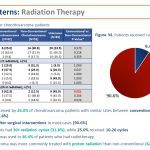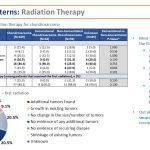Chondrosarcoma Patient Registry indicates Radiation therapy is an effective Post Surgical Treatment Intervention
Chondrosarcoma Patient Registry indicates Radiation therapy is an effective Post Surgical Treatment Intervention in over a third of CS Patients.
The ChondrosarcomaFoundation was the first foundation to be inducted into the NORD IAMRARE Patient Registry 2.0 platform. Since our launch we have had over 230 CS Patients participate in the registry and we just completed our first full data analysis from the data collected from 169 participants who completed all of the surveys in the registry. This is the first global Natural History Study addressing Chondrosarcoma. For the past few weeks we have been sharing major findings (one result at a time) to help both the sarcoma / oncology medical profession and the CS patient community understand and use these results towards developing better protocols, practices / interventions as well as better research and clinical trials. We have looked at the need for CS patients to fully understand their Chondrosarcoma sub-type,as well as address misdiagnosis, recurrence, metastasis and surgery. This week we begin to examine post surgical treatment interventions starting with radiation therapy.
Results: Radiation therapy was received by 26.0% of chondrosarcoma patients with similar rates between conventional (25.0%) and non-conventional patients (30.8%). Radiation was delivered after surgical interventions in most cases (90.6%). A small group of patients (9.4%) tried radiation before they had surgery. Most of the treated patients had 30+ radiation cycles (31.8%), while 25.0% received 10-20 cycles. Proton radiation therapy was used in 36.4% of patients who had radiotherapy. Conventional chondrosarcoma was more commonly treated with proton radiation than non-conventional (62.5% vs. 12.5% which indicated a significant difference p=0.021). Out of radiation-treated patients, second radiation therapy was received by 15.9%.
It was reported that the most common outcome after the first radiation therapy regimen was that 36.4% of treated patients did not have evidence of recurring disease. Another 20.5% of treated patients reported they did not have evidence of any additional tumors and an additional 20.5% of treated patients did not have any change in the size or number of tumors.Further 15.9% reported their tumors showed shrinkage. On the negative side 20.5% reported having additional tumors or growth in existing tumors.
Conclusions: According tothe Chondrosarcoma Patient Registry, radiation therapy is the most utilized post-surgical treatment intervention for chondrosarcoma for both conventional and non-conventional sub-types. In an effort to reduce the size of tumors or for inoperable tumors it was used in 9.4% of CS patients prior to any surgery. A typical treatment regimen of radiation cycles was over 30, although a small percent received 10-20 cycles. Proton Radiation therapy was used mostly for patients diagnosed with Conventional Chondrosarcoma. Approximately 36.4% (over a third) of those receiving radiation therapy reported not having any additional tumors or indicated as having “NERD” No evidence of recurring disease, and 41% reported no change or no additional tumors. Almost 16% reported shrinkage in their tumors. Overall, according to our self-reported data analysis, it appears that radiation therapy can be considered an effective post-surgical intervention tool.
Your participation is essential. Be A Part of the Chondrosarcoma Patient Registry.
To Register: https://chondrosarcoma.iamrare.org/
It is not too late to sign up to participate in the Chondrosarcoma Patient Registry. The register is open at any time for CS Patients or Caregivers to go on-line and complete 9 surveys which will take less than an hour to complete. We need you to share your journey and help progress research in chondrosarcoma.
The Chondrosarcoma Patient Registry creates a platform for patients around the world to strengthen their voices and share information about this rare bone cancer. This global resource will provide data for researchers to use to advance drug development and treatment options and help improve patient care. The patient information that the registry collects will help give direction to scientists on areas in which to focus their research efforts, and to hopefully allow clinicians to see trends in patient responses to treatment for chondrosarcoma. The hope for the future is to illuminate treatments that have had some success that may become the standard of care for this rare bone cancer.


